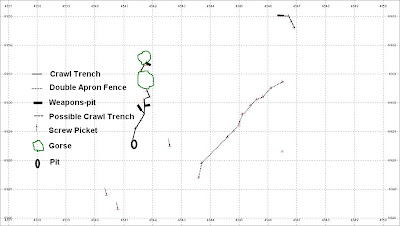As the vegetation begins to die back, it's back to trench mapping field work. As in previous years this will form the baulk of posts over the winter. Unless you are really interested in practice field works, these posts could be quite boring as one hole in the ground looks like another! So I thought I would start with what I think is an interesting survival. What makes this crawl trench system interesting is the surviving wire pickets. A line of long screw pickets and short pickets remain, without doubt the remains of a double apron wire fence. So assuming this earth work was dug for training purposes (to date I have found no Field force localities in the area), it would seem likely that wire was erected as part of the training in constructing this defence post.
Above: GPS plan showing the Crawl Trench system and the remains of the double apron fence. Bottom photo shows the general area - the trench system is in the area of the gorse scrub and its easy to see how the position, located on the high ground, dominates the area.
I actually found this trench during the summer, deciding to visit an area I had never found any signs of earthworks in the past. Apart from a few isolated V shaped weapon-slits this is still the only earthwork I have found in this area to date. There is also no evidence of any live firing exercises (i.e no evidence of shell fragments or .303 cartridges).
Above:
Image 1 - Pit with Crawl trench. The pit could have been a dug-out, mortar pit or anti-aircraft gun pit (i.e Bren or Lewis on an AA mount).
Image 2 & 3: Long screw pickets.
Image 4: Short screw pickets - the diagonal wires of the apron fence would have run from the long pickets to the short pickets. These diagonal wires would have supported the apron wires.
Image 5: Shows my tape acting as a diagonal wire (unfortunately the long picket is bent!). The distance between the base of the two pickets is 5 ft.
Image 6: A sketch of the double apron fence.
Anyway will try and stick in the occasional non "Westleton crawl-trench" post between now and Feb. Other work planned for this winter is some more work on the Eastern Command Line and hopefully a resumption of my annual trip to the Somme in March (really missed not going last March!).
Check out the website - have begun to post some links to film dating from WW2. Also revisit the post on the Demonstration of Obstacle crossings (Part 3 I think for a link to film showing a scissor bridge). I love the footage of British troops in the exercise dressed up as Germans!






